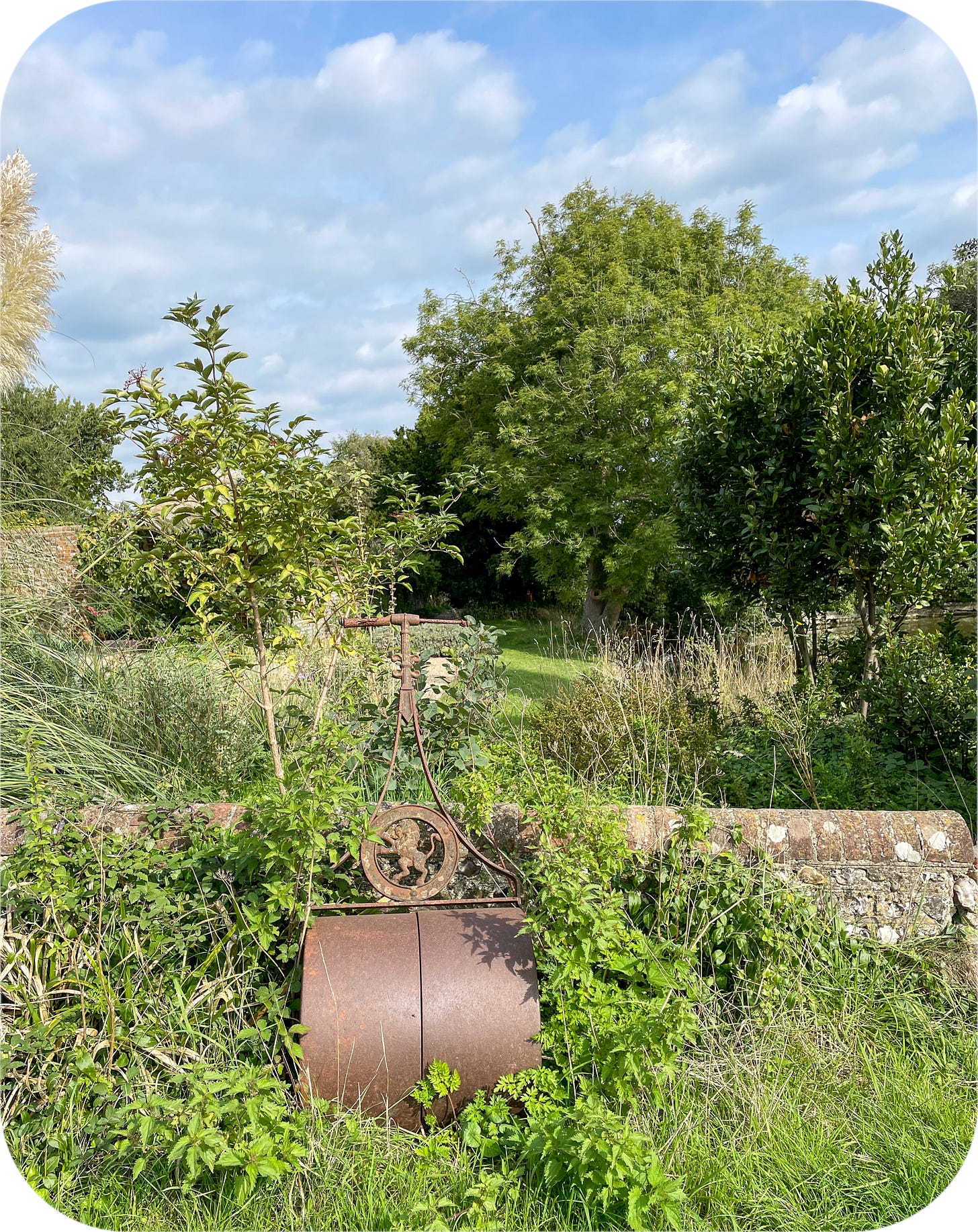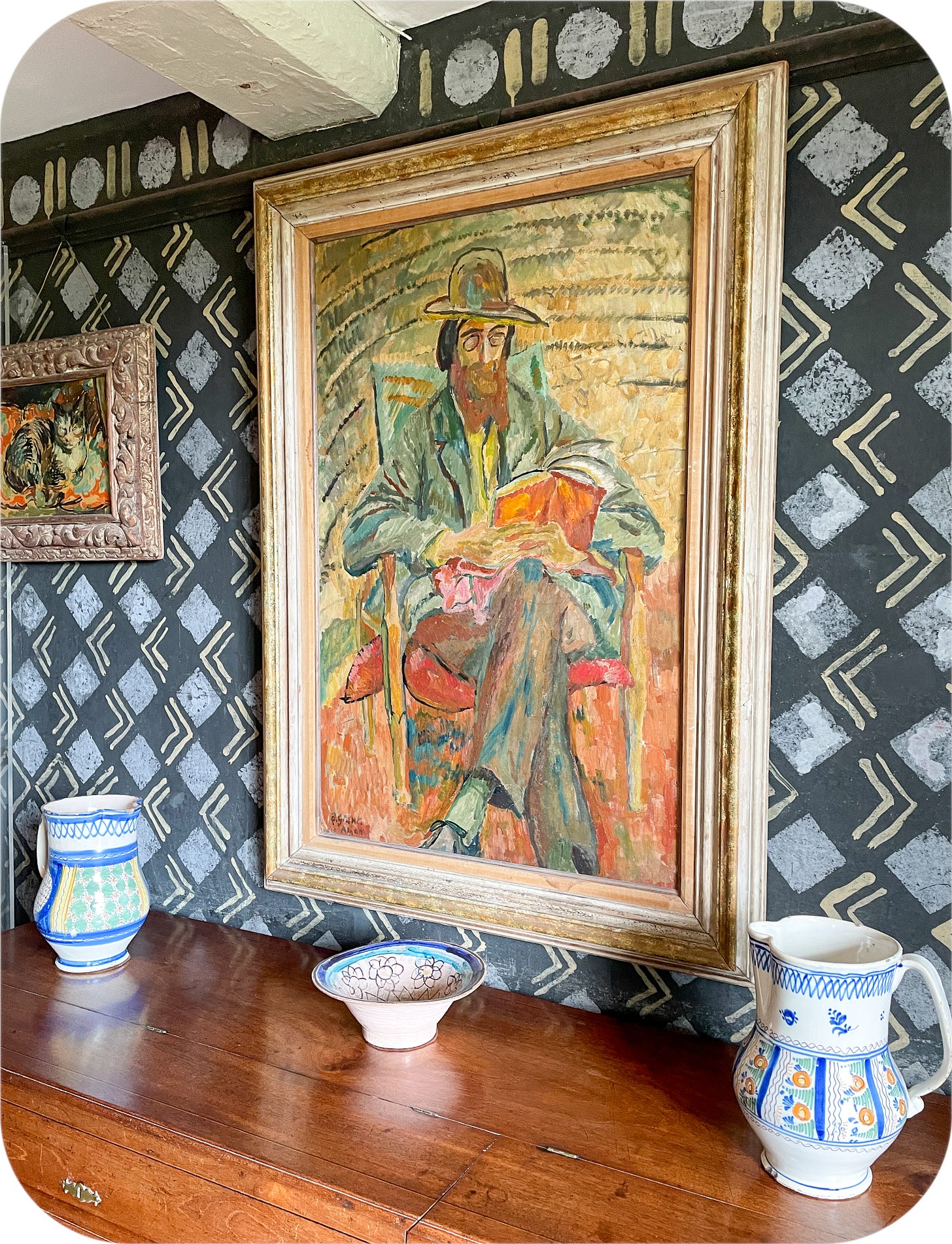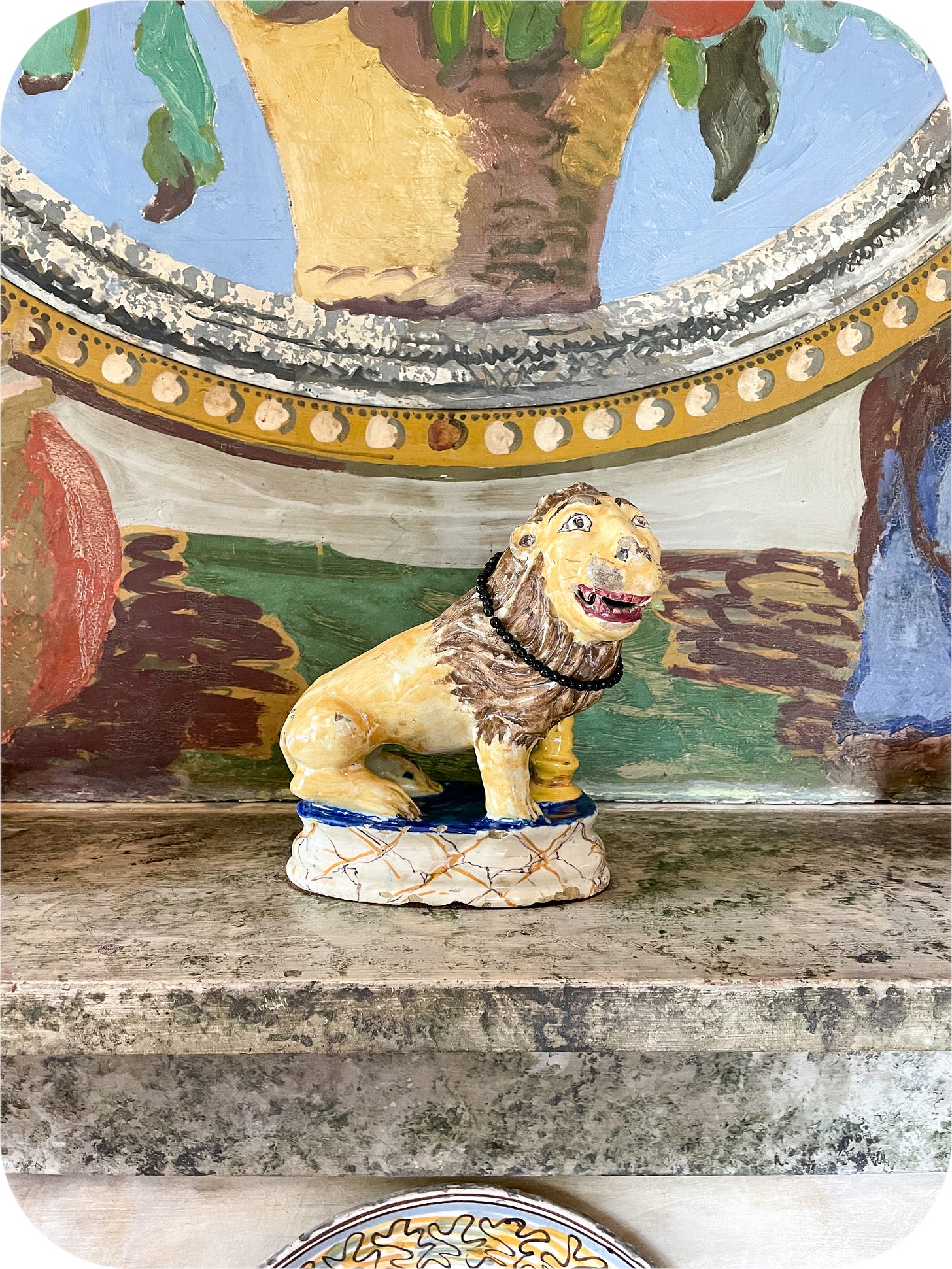Charleston Farmhouse
In which I visit the house that was the heart and soul of the Bloomsbury Group.
It will be an odd life, but…it ought to be a good one for painting…
-Vanessa Bell
The walk from the bus stop to the farm is long and dusty. Cows linger along the fence that lines the way, looking hot and tired and completely fed up with the swarms of flies that buzz and hover under the mid-day sun. Buckets of flowers sit in front of a stone wall nearby, and old garden tools lay next to an abandoned antique lawn mower. Behind the short wall is a garden, and just past the garden a vine-covered house with a red tile roof comes into view.
At first glance, one could be forgiven for thinking that this is just another ordinary - if charming - English farmhouse, nestled in the heart of the South Downs of Sussex. And yet it is far from ordinary. The Guardian newspaper recently called this particular dwelling “the most fashionable house in England”, and people come from far and wide to visit every year. Throngs of them: they come to walk in the footsteps of a select group of people, whose names conjure up images of intellectualism, artistry and free living.
This is Charleston Farmhouse - the home of the artists Vanessa Bell and Duncan Grant, and for a good part of the early twentieth century the heart of the modernist circle known as the Bloomsbury Group.
In the first decade of the twentieth century, four siblings - Vanessa (Stephen) Bell, Virginia (Stephen) Woolf, Thoby Stephen and Adrian Stephen shared housing in the Bloomsbury neighborhood in London. They were intellectually curious and artistic, and hosted regular gatherings of their equally intellectual and talented friends - and the boys’ classmates from Cambridge. Among the regular visitors were writers, artists, historians and economists like Lytton Strachey, John Maynard Keynes, E.M. Forster, Leonard Woolf and Clive Bell. The last two married the Stephen sisters.
Artist & historian Roger Fry was a regular visitor, as was the artist Duncan Grant.
While the Stephen siblings were relatively financially secure, some of their artist friends were not. Sometime in 1913 Roger Fry invited Duncan Grant to visit him at his country home, but Duncan never arrived. When asked why, Duncan simply said that he had set five shillings aside to pay for his journey - but he had put it in such a safe place that he was unable to find it. Without that five shillings, he had no way to pay for his train. It was this incident that inspired Roger Fry to open the Omega Workshops, a decorative arts cooperative that employed artists with the hope that they would be able to earn a living wage. Duncan and Vanessa were co-directors along with Roger Fry, and when the Omega Workshops opened their doors, they did so in a storefront on Fitzroy Square - just a few blocks from the Stephen’s residence on Gordon Square in Bloomsbury.
It has famously been said of the Bloomsbury group that they “lived in squares and loved in triangles”. The squares, of course, refer to the squares in Bloomsbury - but to understand the triangles quip a brief discussion of the love lives of the Bloomsburies is necessary. To map out all of the love affairs, relationships and marriages of the various members of the group would require a map more complex than that of the London Underground, so we’ll stick to our main characters: Vanessa Bell and Duncan Grant.
Vanessa Stephen married Clive Bell in 1907, and the marriage produced two sons relatively quickly: Julian Bell and Quentin Bell. Although they remained married for over fifty years, by the time the Omega Workshops were founded the Bells no longer considered themselves a couple. Clive Bell had a series of extra-marital relationships and lived apart from his wife and sons. Vanessa and Roger Fry were lovers before she fell in love with Duncan Grant - who, for his part, had had affairs with a good portion of the male members of the Bloomsbury group, including Maynard Keynes, Lytton Strachey and the writer David Garnett (nicknamed Bunny).
At the start of the First World War, Vanessa Bell wanted to move her family out of London, and so took a lease on Charleston farmhouse in 1916. Duncan and Bunny were conscientious objectors and could work as farm laborers nearby, and so they came to stay along with Vanessa’s children. Duncan and Vanessa formed a domestic and artistic partnership that lasted for the rest of their lives, and while Duncan continued to have a series of male lovers, he and Vanessa had a child, Angelica, together in 1918.
And here’s where the “loved in triangles” bit gets a little funny: Bunny Garnett - Duncan’s lover at the time of Angelica’s birth - married Angelica in 1942, when she was 24 and he was 50. They had four daughters together before separating. Angelica didn’t find out until after she was married that her husband had been her father’s lover.
Vanessa, Duncan and the kids kept Charleston as a summer residence after the war, and in 1919 Virginia & Leonard Woolf moved into a property nearby - Monk’s House in Rodmell. Quentin Bell would later call the years between the wars the glory days of Charleston, with members of the Bloomsbury group coming and going, and sometimes moving in for extended periods. The family would eventually make Charleston their full-time home, with Clive Bell moving in as well at the start of the Second World War. Duncan Grant continued to live at the property even after Vanessa’s death in 1961 - he kept his home and studio there until his own death in 1978.
Upon her move to Charleston, Vanessa Bell wrote: “It will be an odd life, but it ought to be a good one for painting…”
Charleston is beautiful - but to think that it’s just a beautifully decorated house is to miss the point, I think. The Bell family lived here for almost sixty years, and bit by bit, cupboard by cupboard, room by room they created more than a home - they created their own world. They treated the farmhouse and the surrounding land as their canvas. Charleston wasn’t only where they worked on their artwork, it *was* their artwork.
Beds are painted, bookcases are painted, mantels are painted. Chairs are covered with fabric designed by Duncan, and the curtains were hand-sewn by Vanessa. Roger Fry designed and installed the fireplaces, and Duncan’s mother, Ethel, contributed endless needlepoint rugs and cushions. (Honestly - so many. I can’t imagine how she got it all done.)
The furniture was painted, of course, and even the bathtub.
In the dining room, the black walls are covered by a hand-stenciled square and chevron design - a lot of work that all of the Charlestonians contributed to.
Quentin Bell remembered that the stenciling kept them busy in the days leading up to the outbreak of World War II, and that the tedious work helped to keep their minds off of their worries.
The artists who lived at Charleston obviously spent a great deal of time and energy on decorating it. But it feels like they decorated it to please themselves, and not anybody else. They weren’t trying to make an impression. Souvenirs from their travels are scattered all around, as are paintings and sculptures of and by family and friends. The whole house is filled with books of every kind.
As Quentin grew older he became an artist and potter in his own right, and his creations are scattered around the house and garden as well. A wall in the kitchen is hung with Quentin’s hand-thrown cups - cups that have obviously seen years of use.
All of the inhabitants have left their mark on Charleston - and you can feel it. The guides, too - they talk about Vanessa and Duncan and Angelica as if they were friends…as if they were alive.
“Vanessa painted this painting in 1929, Duncan painted that one the following year. Over there is where Quentin and Julian sat for their studies…” and so forth throughout the house….this is Ducan’s, this is Vanessa’s.
The house was an ongoing project and the work and decoration never ended. When restorers were working on the house, they started to remove some of the paintings from the walls - and discovered that the walls had been painted around the paintings. They were blank behind. You can only imagine Vanessa or Duncan deciding that a room should suddenly be green, and not bothering to remove the items from the walls when they painted.
Our odd family life was indeed one in which laughter was the predominant theme, the leitmotif. We laughed at and with Vanessa, she laughed at and with us, we all laughed at Duncan."
-Quentin Bell
It’s a beautiful home, and a magical one. I find myself not wanting to leave. The tour guides are strict - visitors have a limited amount of time in every room. I imagine that they had too many people like me, who didn’t want to leave, and so restrictions were put into place. When I finish the tour, the first question out of my mouth is: “Can we go through again?” The answer is no, unless we want to buy another ticket. I ask if people do that very often - schedule two tickets in a row - and the guide tells me yes, all of the time.
The last stop on the tour is Duncan Grant’s studio. It’s my favorite room in the house, filled with books and paintings and the spirit of the artist who worked there.
As we turn the corner to leave, a small portrait of Vanessa Bell by Duncan Grant, painted in the last year of her life catches my eye. They were visiting friends in the south of France, and Vanessa is sitting in front of an easel in a light-filled room. Behind her is a window, and flowering trees past that. It’s such a moving portrait of Vanessa: her aging shoulders ever so slightly hunched, but still graceful as can be - paintbrush delicately in hand. The affection of the painter for the sitter is palpable, and I find it very moving. I think about what Vanessa said about her life being an odd one, and it’s true. It was unconventional in so many ways.
But, oh, what she created. And what a beautiful life it was!
























Thank you so much, Amy! I loved it, too - it truly felt magical to me. I loved how every piece of the decor felt infused with love and meaning. I didn’t even have space for photos of the garden… How lucky you are to live close by!
Thanks so much for writing this - I was waiting in eager anticipation, as Charleston is one of my favourite places - I even switched to paid so that I could read the whole article (and will continue the subscription, as I love your writing about other places too!) I know the private lives of the Bloomsbury group are a bit controversial (as mentioned in the previous comment), but I find both the house and its setting below the Downs absolutely magical. I’m fortunate enough to live about 30 minutes away, so am able to visit reasonably regularly and experience the house and garden and its surroundings in different seasons and at different times of the day - the light can make it very changeable. I love the way the house has been decorated and the way the decoration evolved - including the walls, doors, furniture etc - and it has given me lots of creative inspiration!